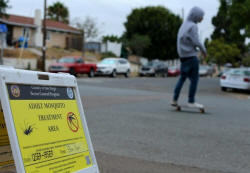|
 More
birth defects in U.S. areas with Zika: U.S. health
officials More
birth defects in U.S. areas with Zika: U.S. health
officials
 Send a link to a friend
Send a link to a friend
[January 26, 2018] By
Julie Steenhuysen
CHICAGO (Reuters) - The mosquito-born Zika
virus may be responsible for an increase in birth defects in U.S. states
and territories even in women who had no lab evidence of Zika exposure
during pregnancy, U.S. health officials said on Thursday.
|
|
 Areas in which the mosquito-borne virus has been circulating,
including Puerto Rico, southern Florida and part of south Texas, saw
a 21 percent rise in birth defects strongly linked with Zika in the
last half of 2016 compared with the first half of that year, the
U.S. Centers for Disease Control and Prevention said in its weekly
report on death and disease. Areas in which the mosquito-borne virus has been circulating,
including Puerto Rico, southern Florida and part of south Texas, saw
a 21 percent rise in birth defects strongly linked with Zika in the
last half of 2016 compared with the first half of that year, the
U.S. Centers for Disease Control and Prevention said in its weekly
report on death and disease.
Researchers said it was not clear if the increase was due to local
transmission of Zika alone or if there were other contributing
factors.
The Zika outbreak was first detected in Brazil in 2015 and spread
through the Americas. It has been linked to thousands of suspected
cases of microcephaly, a rare birth defect marked by unusually small
head size, eye abnormalities and nerve damage resulting in joint
problems and deafness.

For the report, the CDC examined existing birth defect reporting
systems in 14 U.S. states and Puerto Rico to look for birth defects
possibly associated with Zika.
They divided these areas into three groups: places with local Zika
transmission, places with higher levels of travel-associated Zika,
and places with lower rates of travel-related Zika.
Overall, they found three cases of birth defects potentially related
to Zika per 1,000 live births out of 1 million births in 2016, about
the same as the prior reporting period in 2013-2014.
[to top of second column] |

When they looked specifically in areas with local Zika transmission
and looked only at birth defects most strongly linked with Zika,
they saw an increase.
"We saw this significant 21 percent increase in the birth defects
most strongly linked to Zika in parts of the U.S. that had local
transmission of Zika," Peggy Honein, an epidemiologist and chief of
the CDC's Birth Defects Branch, said in a telephone interview. "The
only area where we saw this increase was in the jurisdictions that
had local transmission."
CDC researchers anticipate another increase in possible Zika-related
birth defects when 2017 data are analyzed because many pregnant
women exposed to Zika in late 2016 gave birth in 2017.
(Reporting by Julie Steenhuysen; Editing by Alistair Bell)
[© 2018 Thomson Reuters. All rights
reserved.] Copyright 2018 Reuters. All rights reserved. This material may not be published,
broadcast, rewritten or redistributed.
Thompson Reuters is solely responsible for this content.
 |